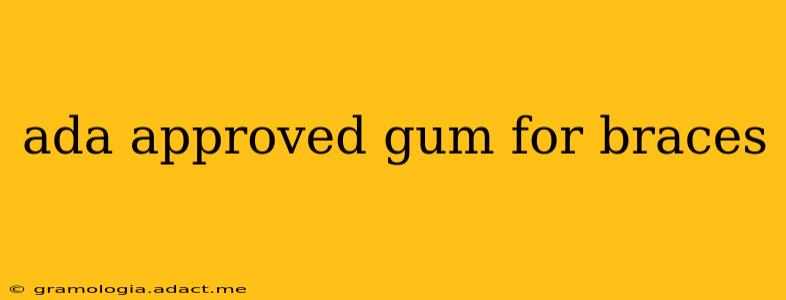Maintaining good oral hygiene is crucial, especially when you have braces. Brushing and flossing diligently are essential, but sometimes, a little extra help is needed. Many people wonder if chewing gum can aid in this process, and the short answer is: yes, some gums can be beneficial, but not all. This guide will explore the criteria for ADA-approved gums and the benefits and drawbacks of using them while wearing braces.
What Does "ADA Approved" Mean?
The American Dental Association (ADA) Seal of Acceptance is a widely recognized symbol of safety and efficacy in dental products. To earn this seal, a product must undergo rigorous testing to prove its claims and meet the ADA's standards for safety and effectiveness. This means an ADA-approved gum has been scientifically evaluated and shown to contribute positively to oral health. Finding gum with the ADA seal assures you that it meets certain quality and safety standards. However, it's crucial to remember that even ADA-approved gum shouldn't replace proper brushing and flossing.
Is Sugar-Free Gum Safe for Braces?
While sugar-free gum is generally better for your teeth than gum containing sugar (as sugar contributes to cavities), the presence or absence of sugar isn't the only factor to consider when choosing gum for braces. The texture and ingredients are equally important. Hard or sticky gums can damage or break your braces, and certain ingredients might irritate your gums or get stuck in your appliances.
What are the Benefits of Chewing Sugar-Free Gum with Braces?
The primary benefit of chewing sugar-free gum, especially after meals, is its ability to stimulate saliva production. Saliva acts as a natural cleanser, helping to wash away food particles and neutralize acids that contribute to tooth decay. This is particularly helpful with braces, as food particles can become trapped more easily around brackets and wires. Look for gums that contain xylitol, a sugar alcohol that has been shown to inhibit the growth of bacteria that cause cavities.
Which Sugar-Free Gums Are Recommended for Braces?
Unfortunately, the ADA doesn't specifically endorse gums for braces. The Seal of Acceptance is given to products demonstrating overall oral health benefits, such as cavity prevention. To find a suitable gum, look for sugar-free options that have the ADA Seal of Acceptance and a relatively soft texture. Avoid chewing excessively hard or sticky gums that could damage your braces. Always consult your orthodontist for personalized recommendations.
Can Chewing Gum Damage My Braces?
Yes, chewing certain types of gum can potentially damage your braces. Extremely hard or sticky gums can bend or break wires, loosen brackets, or cause other damage. Avoid chewing gum that's too hard, sticky, or chewy. It's always best to consult your orthodontist for their specific recommendations regarding gum chewing.
How Often Should I Chew Sugar-Free Gum with Braces?
There's no magic number for how often you should chew sugar-free gum. However, chewing it after meals, for a short duration, can be beneficial to stimulate saliva production and help remove food particles. Overdoing it, however, isn't advisable. Remember, gum is a supplement to proper brushing and flossing, not a replacement.
Are There Any Alternatives to Gum for Cleaning Teeth with Braces?
Yes, there are several other methods for keeping your teeth clean with braces. These include:
- Interdental brushes: These small brushes are designed to reach between your teeth and around your braces, effectively removing food particles.
- Water flossers: Water flossers use a stream of water to clean your teeth and gums, reaching areas that are difficult to clean with traditional floss.
- Dental picks: Dental picks can help dislodge food particles trapped around your braces.
Remember to discuss your oral hygiene routine with your orthodontist to ensure you are employing the most effective methods for your individual needs.
Conclusion:
While some sugar-free gums with the ADA Seal of Acceptance can be a helpful addition to your oral hygiene routine with braces, they should never replace proper brushing and flossing. Choosing a soft, sugar-free gum and chewing it in moderation after meals can stimulate saliva production and help remove food particles, but always prioritize regular brushing, flossing, and professional dental cleanings. If you have any concerns, consult with your orthodontist before incorporating gum into your routine.
